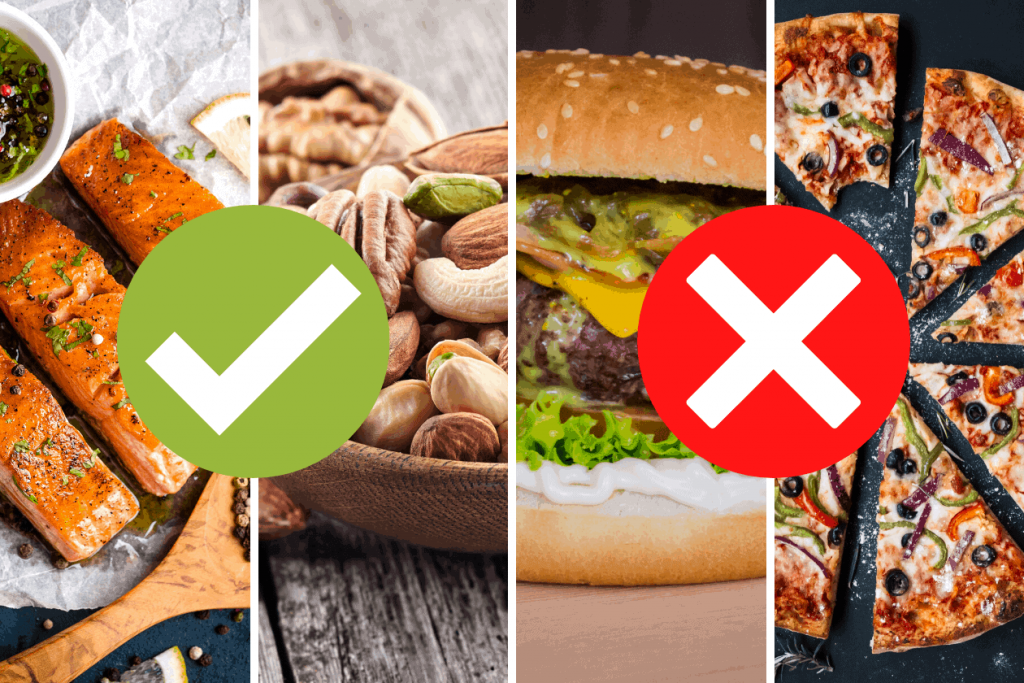
The Whole30 is a diet that resets your metabolism and cleanses your digestive tract. You can't consume junk food or buy store-bought items. And you will need to avoid soy and dairy. It is possible to eat lots of vegetables and fruits. This can be a great alternative for fast-food. There are also recipes for healthy snacks. These nutritious and delicious treats don't have to compromise the flavor of the food you love.
The Whole30 diet allows you eat many different kinds of fruits, vegetables and fats. Although you don't have to avoid all foods, the Whole30 diet does not require you to. You can find the list of forbidden and allowed foods on the website of the Whole30. The Whole30 website also offers a free download of the chart. You can either print it, keep it in your wallet or save it to your smartphone.
However, packaged foods are not allowed. You can however buy them in a shop that has them. The Whole30 list of foods doesn't include them - even though they technically do comply with the diet. Instead, it focuses on eating more natural and unprocessed foods - such as fruit, nuts, and seeds. While you're eating more vegetables than ever, you won't be able to have as much processed meat, so make sure you check the labels carefully.

The whole 30 plan encourages more vegetables than you normally would. Because they are rich in nutrients and fiber, this is a great way to eat more vegetables. While Whole30 doesn't allow you to eat cowboys ribeyes for 30 consecutive days, vegetables are an excellent source of fiber as well as minerals. However, you shouldn't count on fruit as a staple in your diet, since fruits are high in natural sugar. Many people are unaware that they are eating too many sugary foods.
A whole30 diet will allow for you to eat vegetables but not potatoes. You can eat fruits and vegetables without restrictions, but you should avoid processed cheese and red meat, which are known to cause bloating. However, you might have to shop at a supermarket that carries these products.
Other Whole30-friendly foods include eggs and fish. Although you can add them to your salads or stir-fries with them, be careful not to overeat them. You can still eat them in moderation if you choose the right kinds of foods. While you may not be allowed to eat chocolate, you can still enjoy almond butter and carrots. Additionally, almond butter and vegetable liquid can be consumed in moderation.
Although the Whole30 diet is not right for everyone it is an effective way to detox your body, lose weight and improve your health. It's also a great way to start eating better and feel better. If you're trying it for the first time, there are a few things to remember before you begin the program. If you aren’t sure which foods you should include, it is best to eat them as often and as often as possible.

Bananas or plantains can also be fried in coconut oils, which is permitted on the Whole30 food list. Coconut oil can be used to fry plantains and bananas, but avoid overripe bananas. Avocados are another staple of Whole30. They will help control your cravings. The Whole30 diet is best to be consistent for a few months to reap the benefits.
The Whole30 diet is a great way to get rid of bad eating habits. You can cut out sugar and processed foods. You can make your body feel great by eating real, whole foods that aren't processed. It doesn't require any calorie counting, portion measurement, or weight control. Whole30 can be done without following any traditional lifestyle. But you must make sure that you don't have any side effects while you're on the diet.
FAQ
Here are 7 ways to live a healthy lifestyle.
-
Take care of your health
-
Exercise regularly
-
Sleep well
-
Drink lots of water
-
Get enough rest
-
Be happy
-
Smile often
How do I count calories?
You might be asking "What is the best diet?" or "is counting calories necessary?" The answer to this question depends on many factors, including your current health, your personal goals and preferences, as well as your overall lifestyle.
The Best Diet For Me: Which One Is Right?
My personal health, goals and preferences as well as my lifestyle determine which diet is best for me. There are many different diets, some good and some not so good. Some work well for certain people while others don't. What can I do to make the right choice? How do I make the right decision?
This article aims at answering these questions. It starts with a brief introduction of the different types of diets available today. Then we will discuss the pros & cons of each kind of diet. We'll then discuss how to choose which one is best for you.
Let's start by taking a look at the various types of diets.
Diet Types
There are three main types, low fat, high protein, or ketogenic diets. Let's take a look at them all below.
Low Fat Diets
A low fat diet is a diet that restricts the amount of fats consumed. This is achieved through reducing intakes of saturated fats (butter and cream cheese, for example). You can replace them with unsaturated oils (olive oil and avocados) Low fat diets are often recommended to those who wish to lose weight quickly. This diet can cause constipation, heartburn, and stomach problems. A person may also experience vitamin deficiencies if they don't get enough vitamins.
High Protein Diets
High protein diets reduce carbohydrates to favor of proteins. These diets usually have higher amounts of protein than other diets. These diets are meant to increase muscle mass, and burn more calories. However, they might not provide enough nutrition for those who need to eat frequently. They are also very restrictive, so they might not be appropriate for everyone.
Ketogenic Diets
Ketogenic diets can also be known as keto diets. They are high in fat, moderately high in protein and low in carbohydrates. These are often used by bodybuilders and athletes because they allow them the ability to train harder and for longer periods of time without feeling tired. You must adhere to all side effects, including fatigue, headaches, nausea and headaches.
How do you get enough vitamins?
The majority of your daily needs can be met through diet alone. However, if you are deficient in any particular vitamin, taking supplements can help. A multivitamin can contain all the vitamins that you need. You can also get individual vitamins from your local pharmacy.
If you are concerned about getting enough nutrients, talk to your doctor about what foods contain the best sources of vitamins. Dark green leafy vegetables like spinach, broccoli and kale, as well as turnip greens and mustard greens such as turnip and mustard greens and bok choy, are rich in vitamins K & E.
Ask your doctor if there is any doubt about how much vitamin you should be taking. Your medical history and current health will help you determine the best dosage.
Statistics
- The Dietary Guidelines for Americans recommend keeping added sugar intake below 10% of your daily calorie intake, while the World Health Organization recommends slashing added sugars to 5% or less of your daily calories for optimal health (59Trusted (healthline.com)
- This article received 11 testimonials and 86% of readers who voted found it helpful, earning it our reader-approved status. (wikihow.com)
- In both adults and children, the intake of free sugars should be reduced to less than 10% of total energy intake. (who.int)
- WHO recommends consuming less than 5% of total energy intake for additional health benefits. (who.int)
External Links
How To
What does the term "vitamins" mean?
Vitamins can be described as organic compounds found in food. Vitamins aid us in absorbing nutrients from the food we eat. Vitamins cannot be produced by the body. They must be acquired from food.
There are two types of vitamins: water soluble and fat soluble. Water-soluble vitamins dissolve readily in water. You can find vitamin C,B1 or thiamine, B2 or riboflavin and B3 or niacin, B3/niacin, B6/pyridoxine, folic Acid, biotin and pantothenic Acid as examples. Fat-soluble vitamins are stored in the liver, fatty tissue and kidneys. Vitamin D, E, K and A are some examples.
Vitamins are classified based on their biological activity. There are eight major vitamin groups:
-
A – Essential for normal growth, and the maintenance of good health.
-
C - important for proper nerve function and energy production.
-
D - necessary for healthy bones and teeth.
-
E - needed for good vision and reproduction.
-
K – Required for healthy nerves & muscles.
-
P - vital for building strong bones andteeth.
-
Q - Aids in digestion and absorption.
-
R - necessary for making red blood cells.
The recommended daily allowance (RDA) of vitamins varies depending on age, gender, and physical condition. The U.S. Food and Drug Administration (FDA) sets the RDA values.
For adults aged 19 and older, the RDA for vitamin B is 400 micrograms daily. Pregnant women require 600 micrograms daily to support fetal development. Children ages 1-8 require 900 micrograms per day. For infants younger than one year, 700 micrograms are required daily. However, this number drops to 500 micrograms each day for children aged 9-12 months.
Children ages 1-18years who are obese need 800 micrograms per day while those who are overweight need 1000 micrograms per day and children who are underweight need 1200 micrograms per day to meet their nutritional needs.
Children ages 4-8 years who have been diagnosed with anemia need 2200 micrograms per day of vitamin C.
2000 micrograms is the minimum daily intake for adults over 50 years old to maintain good health. Mothers who are pregnant, nursing, or have a high nutrient need will require 3000 micrograms a day.
1500 micrograms are required daily by adults over 70 because they lose approximately 10% of their muscle each decade.
Women who are pregnant or nursing need more than the RDA. Pregnant woman need 4000 micrograms daily in pregnancy, and 2500 per day after childbirth. Breastfeeding moms need 5000 micrograms each day when breastmilk production occurs.